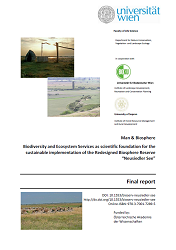

The biosphere reserve Neusiedler See was founded in 1977, three years after the concept of
biosphere reserves was initiated by a Task Force of UNESCO's Man and the Biosphere (MaB)
Programme in 1974. Currently it covers only the lake basin in particular the reed belt and the lake
itself. This rather restrictive designation is excluding large tracts of land with smaller remnants of
natural and semi-natural habitats interspersed with the surrounding agricultural landscape matrix.
The small-scale cultural landscape types situated at the western lakeshore are completely excluded.
This delineation is reflecting the ideas of the MaB-programme in the concept of the 1970s. But it is
not congruent with the criteria of the Seville Strategy as outlined in 1995. Many other biosphere
reserves in the world encounter similar problems, so that the MaB committee decided to withdraw
the label of biosphere reserve by 2013 if a re-implementation will not have been applied for.
While the objective for achieving a sustainable balance between the sometimes conflicting goals of
biosphere reserves is still the same, the context in which biosphere reserves operate has changed
considerably. In 1991 the Convention on Biological Diversity has lead to establish an Advisory
Committee for biosphere reserves. This Advisory Board developed a strategy for a modern kind of
biosphere reserves and drew up the so called Seville Strategy. This broaden strategy tries to
contribute to those changed frameworks. This means to include basic ecological and socio-economic
assessments for zoning and defining conservation, reinforce scientific research and initiate
development tasks (UNESCO, 1996).
Besides the foundation of the biosphere reserve in 1977, substantial progress in conservation
efforts has been achieved by the designation of a RAMSAR site in 1982 and the successful
establishment of Austrias first national park in 1992. Both conservation areas are much larger than
the biosphere reserve and complementing each other in area and management objectives. In
addition, a large area of the whole region including the western lakeshore and its surroundings
has been officially listed by UNESCO as world heritage site for cultural landscape in 2001.
The feasibility of transforming the first generation biosphere reserve Neusiedler See into a modern
one which is compatible with the Seville Strategy was investigated in an forrunner research project
(Redesigning the biosphere reserve Neusiedler See), conducted by the same interdisciplinary team.
In this two years project the possibilities of re-defining and re-designing the biosphere reserve were
studied in a transdisciplinary manner based on a SWOT analysis of the current situation in the
greater Neusiedler See region from a socio-economical and conservation biological perspective. In
the final results mainly realistic and politically agreed planning options for enlargement and redesignation
of the biosphere reserve Neusiedler See were developed. As that project was designed
to give a scientific basis to the decision makers to make up their mind, whether they would like to
proceed with a state-of-the-art biosphere reserve, only a quick assessment procedure based on
available geo-data and expert consultations was conducted.
Universität Wien, Faculty of Life Science,
Department for Nature Conservation, Vegetation- and Landscape Ecology
in cooperation with
Universität für Bodenkultur Wien, Institute of Landscape Development,
Recreation and Conservation Planning
University of Sopron, Institute of Forest Resource Management
and Rural Development
Gefördert durch das „Man and Biosphere Programm“ der Österreichischen Akademie der
Wissenschaften
2012
978-3-7001-7289-5
182 Seiten, zahlreiche Farb-Abb.,